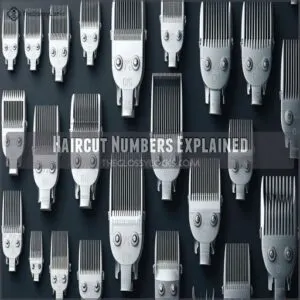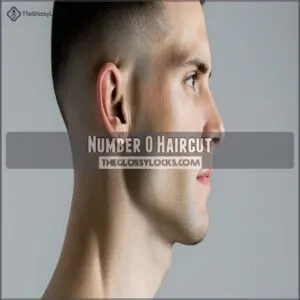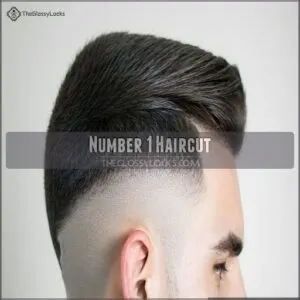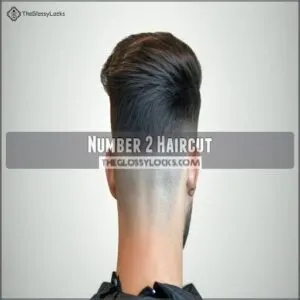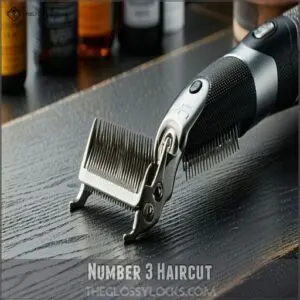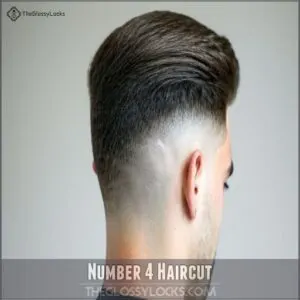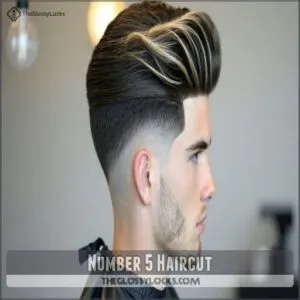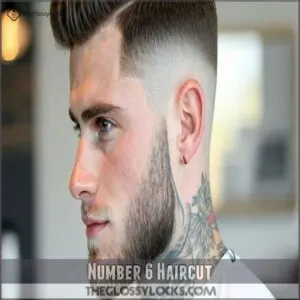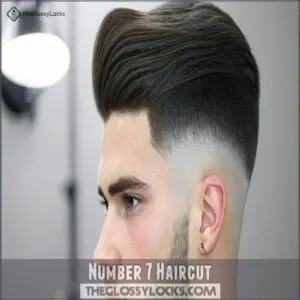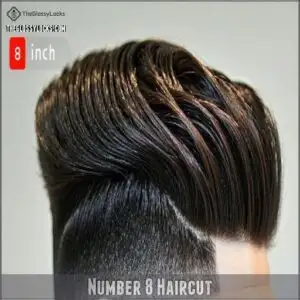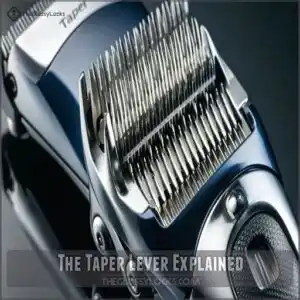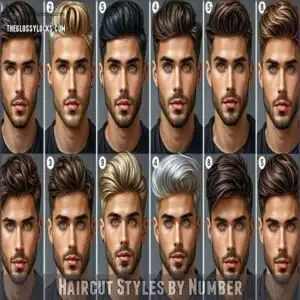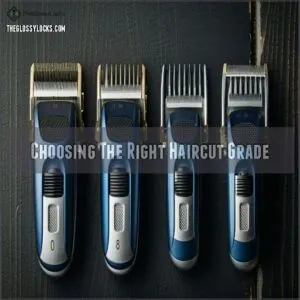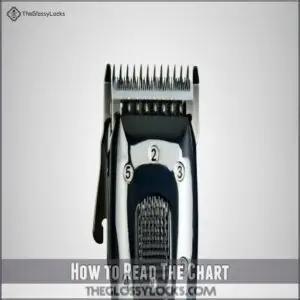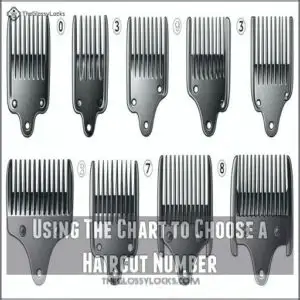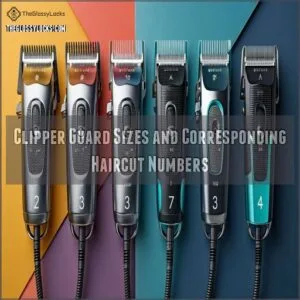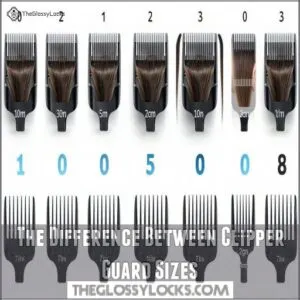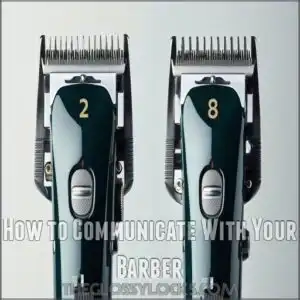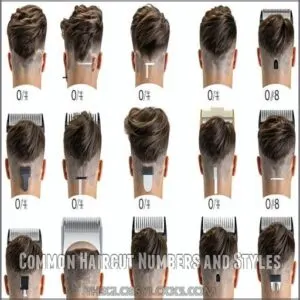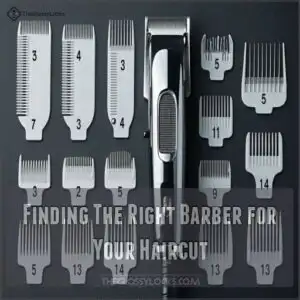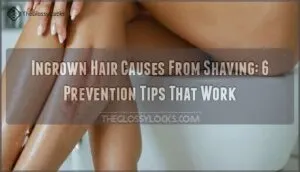This site is supported by our readers. We may earn a commission, at no cost to you, if you purchase through links.
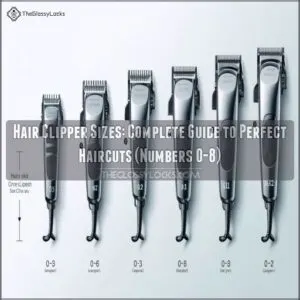 Hair clipper sizes are key to mastering your hairstyle, from a close shave to a longer, stylish cut.
Hair clipper sizes are key to mastering your hairstyle, from a close shave to a longer, stylish cut.
Each number reflects 1/8 inch of hair length. For example, a Number 0 almost shaves your head to the scalp, while Number 8 leaves a full inch.
These numbers aren’t just about length; they guide your style journey. Whether you’re aiming for a military look with a Number 1 or a versatile crew cut at Number 3, the choice radically shapes your image.
Curious about how these sizes can redefine your style and guarantee less frequent barber visits? Let’s unravel the secrets!
Table Of Contents
- Key Takeaways
- Haircut Numbers Explained
- Clipper Guard Sizes in MM
- The Taper Lever Explained
- Haircut Styles by Number
- Choosing The Right Haircut Grade
- Haircut Numbers and Clipper Guard Sizes Chart
- The Difference Between Clipper Guard Sizes
- How to Communicate With Your Barber
- Common Haircut Numbers and Styles
- Finding The Right Barber for Your Haircut
- Frequently Asked Questions (FAQs)
- What does the size of a haircut Clipper mean?
- How many hair clipper sizes are there?
- What is a haircut number & Clipper Guard size?
- How many inches does a number 1 hair clipper leave?
- What size Clipper should I get?
- What size Clipper should I use for a number 2 haircut?
- Is a 3 or 4 shorter haircut?
- How long is a 4 guard haircut?
- What is the length of a number 6 haircut?
- What is a 2 and 4 haircut?
- Conclusion
Key Takeaways
- You’ll master your hairstyle by understanding hair clipper numbers, each representing an increment of 1/8 inch in hair length.
- By choosing the right clipper number, you can tailor your haircut to suit your hair type, face shape, and personal style effortlessly.
- Using a taper lever on your clippers can help fine-tune and blend lengths smoothly without changing guards.
- Communicating your desired haircut number and preferences clearly with your barber ensures you get the style you envision.
Haircut Numbers Explained
You’ll find that haircut numbers directly correspond to the length of hair left after cutting, with each number representing an eighth of an inch increment.
Whether you’re getting a buzz cut or a fade, understanding these numbers will help you communicate exactly what you want to your barber.
avoid any hair-raising surprises. haircut numbers
What Do Different Haircut Numbers Mean?
Ever stared at those clipper numbers wondering what they really mean? Let’s decode the mystery.
Hair clipper numbers tell you exactly how much hair you’ll keep after the cut.
Number 0 leaves barely 1/16" (1.6mm) of hair, almost shaved. Number 8’s full inch (25mm).
Numbers climb up in 1/8" steps – Number 1 leaves 1/8" (3mm), Number 2 gives you 1/4" (6mm), and so on until Number 8’s full inch (25mm).
How to Choose The Right Haircut Number
Three key factors determine your ideal clipper number: your hair type, face shape, and desired style.
If you’ve got thick hair, higher numbers (4-8) give you more styling options. For thin hair, lower numbers (1-3) create an illusion of fullness.
Consider your maintenance level too – shorter cuts need more frequent touchups but are easier to style daily.
Match seasonal trends with your personal preferences for the best results.
Haircut Numbers and Clipper Guard Sizes
Understanding haircut numbers and clipper guard sizes puts you in control of your perfect cut.
The system’s straightforward: numbers 0-8 match guard sizes, with each step up adding 1/8 inch of length.
Number 0 leaves 1/16" of hair, while number 8 gives you a full inch.
Need precision? The taper lever lets you fine-tune between sizes for flawless blends.
Clipper Guard Sizes in MM
You’ll find that hair clipper guard sizes range from 1.6mm to 25.4mm, giving you precise control over your desired hair length.
Each number on your clipper guard corresponds to a specific length in millimeters.
Making it easier for you to achieve consistent results whether you’re at home or communicating with your barber.
Number 0 Haircut
Ready to take control of your look? A Number 0 haircut leaves your hair nearly skin-level, creating that sharp, ultra-close cut you’re after.
Without a guard attached, you’ll get different lengths based on your clipper’s settings, and understanding the clipper guard sizes will help you achieve the style you want.
| Haircut Number | Length (in) | Length (mm) |
|---|---|---|
| 0 | 0 | 0 |
| 0 | almost bald | 0.5 |
| 0 (zero-gap) | 1/16 | 1.5 |
| 0 (bald fade) | very short | 0.8 |
Number 1 Haircut
A Number 1 haircut leaves your hair at exactly 1/8 inch (3mm), striking the sweet spot between ultra-short and barely-there.
It’s perfect for hot summer days or achieving that clean military look.
The style works great for fades, particularly when blending with a Number 0 at the bottom.
While it won’t hide scalp visibility, it’s incredibly low-maintenance and grows out evenly.
Number 2 Haircut
A Number 2 haircut gives you 1/4 inch (6mm) of hair length, striking the sweet spot between super-short and slightly grown out.
It’s the go-to choice for both clean-cut professional looks and edgy styles.
You’ll find it’s perfect for hiding minor scalp imperfections while being short enough to stay cool.
Many guys love this length because it works well with fades, buzz cuts, and military-style cuts. This makes it a versatile option. It’s also great for hiding imperfections.
Number 3 Haircut
A Number 3 haircut hits that sweet spot at 3/8 inch (10mm), giving you enough length to play with while keeping things neat.
It’s perfect if you’re wanting a clean look that won’t need constant touch-ups.
Your barber can use this guard for a classic crew cut, or blend it into shorter sides for a more dynamic style.
Works great with most hair types and face shapes. This makes it a versatile option.
Number 4 Haircut
A Number 4 haircut leaves your hair at a versatile 1/2 inch (13mm) length, striking the perfect balance between style and manageability. If you’re moving up from a Number 3, you’ll notice more styling flexibility while maintaining that clean-cut look.
- Perfect for professional environments while offering styling options
- Works exceptionally well for both thick and fine hair types
- Ideal base length for classic crew cuts and brush-ups
- Requires minimal maintenance with weekly touch-ups
Number 5 Haircut
The Number 5 haircut strikes a perfect balance between manageability and style, leaving your hair at a versatile 5/8 inch (16mm) length.
You’ll get enough hair to work with, making it ideal for textured styles and modern looks.
It’s particularly flattering for oval and heart-shaped faces, and you can easily maintain it with minimal styling product.
For added flair, consider pairing it with a fade for contemporary contrast.
Number 6 Haircut
A Number 6 haircut leaves your hair at a versatile 3/4 inch length, perfect for classic styles like pompadours and slick backs.
Here’s what you need to know:
| Number 6 Haircut Style | Description |
|---|---|
| Pompadour with #6 | Creates volume and texture for a timeless look |
| Fade with #6 | Modern blend from sides to longer top |
| 6 for Thick Hair | Manageable length for dense hair |
| 6 Haircut Maintenance | Easy styling with minimal product needed |
Number 7 Haircut
Stepping up to a Number 7 haircut puts you in control of a generous 7/8 inch (22mm) of hair length, striking that sweet spot between short and medium styles.
Here’s what makes this length special:
- Perfect for classic crew cuts with plenty of styling options
- Ideal for thick hair that needs some weight
- Great foundation for textured looks on top
- Low-maintenance yet versatile for daily styling
Number 8 Haircut
At a generous 1-inch length, Number 8 guards give you maximum styling versatility while keeping things manageable.
You’ll enjoy these key benefits:
| Style Option | Best For | Maintenance Level |
|---|---|---|
| Textured Top | Thick Hair | Medium |
| Classic Brush | Any Hair | Low |
| Modern Quiff | Straight Hair | High |
| Faux Hawk | Dense Hair | Medium |
| Side Part | Fine Hair | Low |
The Taper Lever Explained
You’ll find the taper lever on the side of your hair clippers.
It’s your secret weapon for creating smooth fades between different lengths.
This handy feature lets you make micro-adjustments to the blade position without changing guards.
Giving you precise control over your haircut’s final look.
How to Use The Taper Lever
Your clipper’s taper lever opens up a world of precision cuts and seamless blends. It’s perfect for creating those butter-smooth shifts between different lengths.
Located on the side of your clippers, this metal tab controls blade overlap, letting you fine-tune hair length without switching guards.
Think of it as your fade’s secret weapon – when closed, it cuts shorter, and when open, it leaves hair slightly longer.
You can find high-quality taper levers and accessories specifically designed for your hair clippers at clipper taper lever products.
Adjusting The Taper Lever for Different Lengths
Moving the taper lever while cutting creates seamless changes between different lengths.
By adjusting the lever gradually as you work, you’ll achieve professional-looking fades and blends.
The key is smooth, controlled movements—think of it like a volume slider for your haircut’s precision.
Practice makes perfect, so start with small adjustments until you’re confident in your technique.
The Difference Between Closed and Open Taper Settings
The closed and open positions of your taper lever give you precise control over your haircut’s final look.
Here’s what each setting achieves:
| Setting | Effect | Best For |
|---|---|---|
| Closed | Shorter cut | Crisp lines |
| Mid | Subtle blend | Smooth fades |
| Open | Longer cut | Textured looks |
This simple adjustment lets you fine-tune length and texture without switching guards.
Haircut Styles by Number
You’ll find the perfect haircut style for your preferences.
Clipper sizes range from a close-cut number 0 to a longer number 8 length.
Whether you’re looking for a sleek fade or a fuller cut on top, each number creates a distinct look that can transform your appearance.
Number 0 Haircut Styles
Embracing a number 0 haircut means going bold with just 1/16 inch of hair length – perfect for those ready to make a statement.
This ultra-short cut delivers three key benefits: maximum cooling effect during hot summer months, virtually zero daily styling maintenance, and creates a clean foundation for precise hairstyles for balding men, such as the classic High and Tight look.
Remember to protect your exposed scalp with sunscreen, as this close-cut style leaves little natural protection.
Number 1 Haircut Styles
Stepping up your style game with a Number 1 haircut (1/8 inch) opens doors to fresh looks while keeping things low-maintenance. Whether you’re aiming for a sleek fade or want to emphasize your facial features, this length hits the sweet spot between super-short and manageable.
| Style | Best For | Maintenance |
|---|---|---|
| Classic Fade | Sharp features | Weekly touch-ups |
| Military Cut | Active lifestyle | Bi-weekly trim |
| Urban Crop | Textured hair | Monthly upkeep |
| Skin Fade | Bold look | Every 2-3 weeks |
Number 2 Haircut Styles
Rocking a Number 2 haircut gives you that sweet spot between effortless maintenance and styling flexibility.
At 1/4 inch (6mm), you’ve got enough hair to play with while keeping that clean, sharp look.
Popular styles include:
- Classic military-inspired high and tight
- Modern fades with textured tops
- Low-maintenance crew cut variations
- Professional taper fades
Perfect for both office life and weekend adventures.
Number 3 Haircut Styles
The number 3 haircut, leaving 3/8 inch of hair, hits the sweet spot between super-short and manageable length.
It’s perfect for trying classic styles like the butch cut or crew cut while keeping maintenance minimal.
| Style | Description | Best For |
|---|---|---|
| Crew Cut | Classic short style with longer top | Athletic, low-maintenance look |
| Fade | Gradually blended sides and back | Modern, stylish appearance |
| Textured Crop | Choppy, textured top with short sides | Adding volume to fine hair |
Number 4 Haircut Styles
With a Number 4 haircut (1/2 inch), you’ll get that sweet spot between short and medium length that works for nearly any style, especially timeless hairstyles like the Classic Comb Over.
It’s perfect for crew cuts and brush-ups, giving you enough hair to play with without daily maintenance headaches.
This length flatters most face shapes and works equally well for thick or thin hair, making it a go-to choice for modern, versatile looks.
Number 5 Haircut Styles
A Number 5 haircut strikes the perfect balance between low-maintenance and style flexibility.
At 5/8-inch (16mm), this length gives you plenty of options.
You’ll find it’s particularly popular for classic military buzz cuts and modern textured styles. Style it sleek with a side part, create a textured quiff, or pair it with a fade for a clean, professional look.
It’s especially great for thick hair that needs some weight removed. This length is particularly versatile.
Number 6 Haircut Styles
Sporting a number 6 haircut leaves you with 3/4 inch of hair, perfect for crafting versatile styles from flat tops to faux hawks.
This length works especially well for guys with thick hair or those wanting more styling options.
You’ll have enough length to create texture and movement, while still keeping maintenance relatively simple. Consider pairing it with shorter sides for a modern, dimensional look. This length is perfect for versatile styles.
Number 7 Haircut Styles
Moving up to a number 7 clipper guard, you’ll get hair that’s 7/8 inch (22mm) long.
This length works especially well if you’ve got thick hair or want to maintain some natural texture.
perfect for creating classic crew cuts with extra styling versatility.
You can style it into a neat, professional look or leave it slightly tousled for a more casual vibe. This length is ideal for various styles.
Number 8 Haircut Styles
An inch of liberating length awaits with the Number 8 haircut – your ticket to versatile styling and personal expression.
This guard size opens up a world of possibilities for those seeking more hair real estate.
Here’s why Number 8 might be your new go-to:
- Maximum styling flexibility
- Enough length to experiment with texture
- Works great for thick or thin hair
- Perfect for growing out shorter styles
Choosing The Right Haircut Grade
Choosing the right haircut grade isn’t just about length—it’s about finding your perfect style.
Finding your perfect style complements your unique features.
From your hair type and face shape to personal maintenance preferences, understanding clipper sizes will help you nail the look.
That makes you feel confident and sharp.
Hair Type and Haircut Grade
By the time you hit the barbershop, your hair type’s calling the shots for your perfect clipper grade. Fine hair? Short clips boost volume. Thick hair? You’ve got style flexibility.
| Hair Type | Recommended Clipper Grade | Style Impact |
|---|---|---|
| Fine Hair | Numbers 1-3 | Adds volume, creates texture |
| Thick Hair | Numbers 3-6 | Manages bulk, provides shape |
| Mixed Texture | Varied Grades | Customized styling options |
Mastering your hair’s unique personality means choosing the right clipper number.
Hair Texture and Haircut Grade
Your hair’s texture transforms the entire haircut game.
Curly locks shrink dramatically, often requiring a higher guard number to hit your desired length.
Straight hair plays it straight (pun intended), while fine hair demands a precision approach.
Thick manes need strategic clipper sizing to prevent bulk, and wavy textures require their own special considerations.
The right guard number is your ticket to a killer look that works with – not against – your natural hair texture.
Face Shape and Haircut Grade
If your face shape could talk, it’d beg for the right haircut.
Round faces need length on top to elongate features.
Square faces benefit from softer, tapered styles that smooth sharp angles.
Oval faces? You’ve hit the genetic lottery – most haircut grades look killer on you. Oval faces
Heart-shaped faces should balance chin width with strategic volume. Heart-shaped faces
Preferred Maintenance and Haircut Grade
Matching your haircut to your lifestyle isn’t just smart—it’s a game-changer.
Low-maintenance styles save precious morning minutes, while high-effort cuts demand more time and products.
Consider your daily routine: Are you a busy professional, an active athlete, or someone who loves spending extra time styling? Your clipper number can make or break your morning efficiency and overall look.
Personal Style and Haircut Grade
Crafting your perfect haircut goes beyond just numbers – it’s about expressing your unique personality.
Style is the secret sauce that transforms a simple trim into a statement.
Consider these key elements when choosing your clipper grade:
- Reflect your personal vibe and lifestyle
- Showcase your confidence through hair
- Complement your individual aesthetic
Your hair tells a story. Make it epic.
Haircut Numbers and Clipper Guard Sizes Chart
You’ll discover the secrets to perfect haircuts once you master the hair clipper numbers chart.
Whether you’re heading to the barbershop or trimming your own hair at home, understanding clipper guard sizes will help you communicate exactly the look you want.
How to Read The Chart
Understanding your hair clipper size chart can feel like cracking a secret code, but it’s easier than you think.
Let’s break down this visual roadmap to hair perfection.
Check out this handy reference guide that’ll turn you into a clipper chart pro:
| Clipper Number | Hair Length (inches) | Hair Length (mm) |
|---|---|---|
| 0 | 1/16" | 1.6 |
| 1 | 1/8" | 3.2 |
| 2 | 1/4" | 6.4 |
| 3 | 3/8" | 9.5 |
Master these numbers, and you’ll speak the barber’s language like a pro.
Using The Chart to Choose a Haircut Number
After deciphering the chart’s layout, you’ll find choosing your perfect haircut number isn’t rocket science.
Think of it like picking your favorite coffee – it’s all about personal preference.
To get started, you can explore various hair clipper guards to find the right fit for your style.
Your hair type, face shape, and style goals are the real decision-makers.
Whether you’re going for a bold buzz or a subtle taper, the chart’s your roadmap to hair confidence.
Clipper Guard Sizes and Corresponding Haircut Numbers
Knowing your clipper guard sizes is like having a secret map to the perfect haircut.
This chart breaks down exactly how each clipper number translates to hair length, from the buzz cut basics to longer styles.
Whether you’re into DIY haircuts or want to nail your barber communication, understanding these sizes is your ticket to style confidence. This is essential knowledge for anyone interested in cutting their own hair or communicating effectively with their barber.
The Difference Between Clipper Guard Sizes
Understanding clipper guard sizes is important for achieving your perfect haircut.
Each guard number represents a specific hair length.
Knowing the differences helps you communicate exactly what you want to your barber.
Number 0 Vs Number 1
Switching from the previous topic of clipper guard charts, let’s see the impact of choosing between Number 0 and Number 1 cuts.
To achieve the perfect Number 0 cut, it’s essential to invest in the right equipment, such as a clipper size 0 from a reliable online store like Clipper Size 0 Products.
Number 0 gives a near-shave look, perfect for those craving simplicity or a military vibe.
Meanwhile, Number 1 leaves a bit more stubble, offering a shadowed, low-maintenance style perfect for those who want a subtle transformation.
Number 2 Vs Number 3
So, you’re torn between a #2 and a #3 haircut?
A #2 leaves a ¼ inch—great for buzz cuts and fades. A #3 gives you 3/8 inch—perfect for crew cuts.
The visual difference is noticeable! Consider your hair type; a #3 might be better for thicker hair.
Both offer good styling versatility, but the overall length is key. Check a hair clipper number chart for a clearer picture.
Number 4 Vs Number 5
Comparing a number 4 and 5 haircut feels like eyeing the difference between a drizzle and light rain.
Choosing the right number also depends on your hair type and face shape, as oval face shapes can pull off a variety of looks, while round faces may benefit from longer top lengths.
Number 4 leaves hair at 1/2 inch, ideal for classic crew cuts.
Number 5 at 5/8 inch offers more styling leeway, perfect for experimenting with fades or managing your hair’s thick or thin personality.
Check your hair clipper numbers to decide!
Number 6 Vs Number 7
Number 6 or Number 7 guards? They’re your secret weapon for a neat, stylish look.
While Number 6 leaves 3/4 inch, and Number 7 leaves 7/8 inch, each offers unique styling flair:
- Ideal for thick hair textures
- Perfect for slick backs or pompadours
- Great for sophisticated taper fades
Mastering these lengths boosts your grooming game effortlessly!
Number 8 Vs Longer Haircuts
Once you hit the Number 8 haircut, you’re at 1 inch—your last stop before breaking out the scissors.
It’s got style potential and maintenance puts you in command.
Beyond #8, longer styles call for new techniques.
Embrace the extra hair with versatile styles and creativity, ensuring your look stays fresh while mastering the art of hair clipper sizes.
How to Communicate With Your Barber
When you visit your barber, clearly explaining your desired haircut number can make all the difference in getting the haircut you envision.
Consider discussing your hair type, texture, and personal style to guarantee there are no surprises in the final look.
Explaining Your Desired Haircut Number
When you sit in the barber’s chair, say, "I’d like a number 3 on the sides."
Bringing client photos helps clarify what you mean.
Also, describing length using everyday terms like "finger-length" or "just above the ears" avoids misunderstandings.
Visual aids and clear communication guarantee you leave with the haircut you envisioned.
Discussing Hair Type and Texture
Your barber needs to know your hair’s personality! Straight hair? Easy peasy.
Wavy? Might need some layering.
Curly? It shrinks when it dries, so keep that in mind.
Thick hair? Thinning might be needed. Fine hair? Let’s add some volume.
This helps them give you the perfect cut. Discuss your hair’s quirks—they’ve seen it all!
Describing Your Face Shape and Personal Style
Face shapes and style preferences can guide you to the perfect haircut.
Know your face shape—whether it’s oval, round, or square.
If you have a round face, consider haircuts for round faces men to add height and create a slimming visual effect.
Describe your desired look by sharing inspiration pics or style icons.
Talk about your lifestyle and how much maintenance you prefer.
With this info, your barber can help you find the best haircut to suit your personality.
Common Haircut Numbers and Styles
Understanding common haircut numbers and styles can feel like deciphering a secret code, but it really simplifies your barber visits.
From close-cropped styles like the number 3 to longer looks with a number 8, knowing these numbers helps you get exactly the haircut you want.
Number 3 Vs Number 4 Haircuts
Deciding between a Number 3 and a Number 4 haircut comes down to style and convenience.
A Number 3, leaving 3/8 inch, offers a neat, classic look that’s easy to maintain.
Meanwhile, a Number 4 gives you half an inch of hair, providing more styling options and a slightly softer appearance, ideal for various hair types and face shapes.
Number 5 Vs Number 6 Haircuts
Diving into haircuts, numbers 5 and 6 offer distinct lengths. With a number 5, expect 5/8 inch, offering some versatile styling options. A number 6 provides 3/4 inch, perfect for styles like pompadours.
Consider:
- Length difference impacts look
- Options for fades
- Texture influences style
- Works for various face shapes
- Clipper size versatility
Number 7 Vs Number 8 Haircuts
When you’re looking at number 7 and number 8 haircuts, it’s all about styling options and versatility.
With these lengths, you have more control over your overall look.
Ideal for various face shapes and hair textures, they offer excellent coverage for thinning hair and require low maintenance—especially for curly or thick hair.
Perfect for anyone wanting a bit more freedom in style!
Popular Haircut Styles by Number
Think haircut numbers are all the same? Think again.
Each clipper size offers a unique vibe.
A Number 1 Haircut gives you that edgy, almost-bare look, while a Number 3 Haircut delivers a classic buzz cut.
A Number 4 Haircut for a balanced, tidy style.
Exploring these numbers opens endless style trends and fade options.
Finding The Right Barber for Your Haircut
Finding the right barber can make or break your haircut, so choosing wisely is important!
Look for someone who understands clipper numbers and can execute your desired style precisely.
Making your next trip to the barbershop a breeze.
How to Find a Barber Who Understands Haircut Numbers
Finding a barber who gets haircut numbers is like searching for hidden treasure.
Start with online reviews to hear about their skills.
Don’t be shy—ask friends for tips on local pros.
Spot barbers engaged in hair communities; they tend to be passionate.
What to Look for in a Barber
Choosing the right barber means weighing barber experience and skill level carefully.
Explore client reviews to discover real-life barber artistry.
Consider the shop environment and price range that suits your budget.
Also, some barbers specialize in certain styles or work best with particular hair types. Look for someone who knows their clipper guard sizes and haircut numbers.
How to Communicate Your Haircut Needs to Your Barber
Walking into a barbershop can feel like stepping onto center stage.
Bring along visual aids, like pictures of your desired style, and share insights about your hair texture.
Mention specific lengths using haircut numbers as your guide.
Don’t hesitate to discuss fade techniques, ask about the buzz cut or fade haircut, and clarify your expectations for a perfect trim.
Frequently Asked Questions (FAQs)
What does the size of a haircut Clipper mean?
Did you know a clipper’s size controls the hair length post-cut?
With sizes from 0 to 8, each step increases by 1/8 inch.
Picking the right size guarantees your haircut’s just the length you want!
How many hair clipper sizes are there?
There’s no single answer! Most clipper brands offer guards numbered 0-8, each adding 1/8 inch of length. Some go even higher, providing lots of options for your perfect cut.
What is a haircut number & Clipper Guard size?
Imagine mastering your look like a pro.
A haircut number corresponds to a clipper guard size, determining hair length during a cut.
Numbers range from 0 (shortest) to 8 (longest), providing flexibility in styling choices.
How many inches does a number 1 hair clipper leave?
Using a number 1 clipper guard leaves your hair about 1/8 of an inch long.
It’s perfect for a super short style.
Offering a clean-cut look that’s both easy to maintain and stylishly bold.
What size Clipper should I get?
Choose a clipper size based on desired hair length: number 1 for short buzz, number 4 for medium styles, or number 8 for longer trims.
Match clipper numbers to your style preference for best results.
What size Clipper should I use for a number 2 haircut?
For a number 2 haircut, you should use a clipper with a Number 2 guard.
leaving approximately 1/4" of hair.
This length is great for a clean, low-maintenance look that works well for fades.
Is a 3 or 4 shorter haircut?
A number 3 haircut is shorter than a number A number 3 leaves 3/8 of an inch of hair, while a number 4 leaves 1/2 inch. Choose based on how short you prefer your hair.
How long is a 4 guard haircut?
A 4 guard haircut leaves your hair about 1/2 inch (7 mm) long. It’s a versatile choice, suitable for those wanting a bit more length while maintaining a neat, manageable style.
What is the length of a number 6 haircut?
Ready to express your inner stylist? A number 6 haircut gives you ¾ of an inch of hair. That’s enough length for some serious styling options! It’s versatile, so you’re in control.
What is a 2 and 4 haircut?
A 2 and 4 haircut combines lengths of 1/4" and 1/2". The number 2 is used for shorter sections, like the sides, while the number 4 maintains a medium length on top for contrast.
Conclusion
Imagine this: You want a haircut and confidently ask your barber for a Number 3.
Thanks to understanding hair clipper sizes, you’re on your way to achieving that perfect look.
Knowing the difference between a Number 0 buzz cut and a Number 8 trim guarantees you get the style that suits you best, whether you’re doing it yourself or visiting a professional.
With this guide, your hair journey becomes easy, saving time and avoiding mishaps.
- https://www.menshairstylesnow.com/haircut-numbers/
- https://menshairstylesfix.com/haircut-numbers-hair-clipper-sizes/
- https://atozhairstyles.com/articles/haircut-numbers-guide-to-hair-clipper-sizes/
- https://wisebarber.com/hair-clipper-guard-sizes/
- https://hairstylecamp.com/haircut-numbers-and-hair-clipper-sizes/

